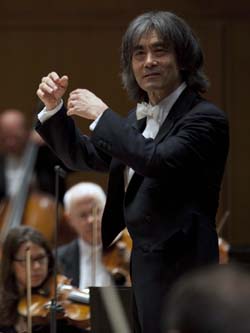
By Eileen Wingard


SAN DIEGO — Orchestre Symphonique de Montreal, under their California-bred conductor, Kent Nagano, performed a virtuoso program at the Irwin and Joan Jacobs Music Center last Wednesday evening.
Because the printed programs of the sponsoring La Jolla Music Society did not include biographical notes on the performers, Kristin Lancino, the new President and Artistic Director of the organization, came on stage to introduce them. She also expressed special thanks to Irwin and Joan Jacobs for their support.
We of the Jewish Community are well aware of the great generosity this couple extends, especially to the performing arts, to engineering education, and to the Jewish Community of San Diego, and joined in the loud applause.
With Montreal steeped in French language and culture, it was fitting that the touring program of the Orchestre Symphonique de Montreal should have a strong French connection. The three featured composers had spent time in Paris during all or part of their lives.
Claude Debussy (1862-1918) was born outside of Paris and lived most of his life in that city. Russian-born Igor Stravinsky (1882-1971) resided in France, between the two World Wars, and Russian-born Sergei Prokofiev (1891-1953) spent a decade in Paris prior to returning to his beloved homeland.
The program was bookended by two works of Claude Debussy, his 1913 ballet, Jeux: poeme danse, choreographed by the great Russian dancer, Nijinsky, and the first encore, Debussy’s tone poem for orchestra and considered by many, his masterpiece, Prelude a l’apres-midi d’un faune (Prelude to Afternoon of a Faun). Although Jeux did not meet with great success as a ballet, the orchestral score is often viewed as one of Debussy’s greatest achievements.
Whereas, in Afternoon of a Faun, composed in 1894, there is an enchanting flute solo which repeats in the oboe and returns at the end, and the impressionistic harmonies paint a misty background of sound, Jeux is devoid of discernable melody. Instead, the music relies on impressionistic textures with timbres and rhythms in sequential climaxes. It seemed to fulfill Debussy’s goal to write music “free from motives and themes, founded in reality on a single continuous theme which nothing would interrupt and which would never return upon itself.” As my companion, former wife of a conductor, remarked, “There was nothing I could sink my teeth into.”
The brilliant young Russian pianist, Daniil Trifonov, gave a definitive performance of Prokofiev’s third piano concerto. Prokofiev was a classicist. He once said, “I write for nothing simpler or more compact than the sonata form, which contains everything necessary for the development of my ideas.” Prokofiev’s Piano Concerto #3 is a prime example of his classical framework.
Trifonov’s abundant technique tossed off the perpetual motion passages in the first movement with confident abandon and he rendered the lyrical sections, especially in the second movement, with heartfelt passion. The last movement had a jazz-inspired theme, probably a result of Prokofiev’s exposure to that American idiom during the years he concertized in the United States, 1918-21 or the time he lived in Paris 1922-1932 where jazz was the rage. A standing ovation brought Trifonov back for an encore, the light-hearted Silver Fairy by Peter Illych Tchaikovsky in a piano arrangement by Mikhail Pletnev.
After intermission, Nagano and his forces performed one of the most challenging works in the repertoire, Igor Stravinsky’s Le sacre du printemps (The Rite of Spring). This ballet was also choreographed by Nijinsky. It has become a signature work for the Montrealers, having toured with it and recorded it under their previous conductor, the Swiss-born Charles Dutoit. That recording was honored with a Felix award in Quebec. Their current conductor, Kent Nagano, led the work in 2012 and 2016 as well as on this tour. The Rite of Spring was performed with inspiring momentum as Nagano’s meaningful gestures achieved exciting results. The orchestra attacked the work with consummate energy and control. Highlights included the superbly played opening bassoon solo, the barely-audible muted trumpets, so soft was their pianissimo, and the execution of the elaborate beat patterns, with constant change of meters, reflecting the savagery of the primitive rites, the sacrifice of a young virgin.
The audience’s rousing applause garnered two encores, Prelude a l’apres-midi d’un faune and “Farandole” from the L’Arlesienne Suite by another French composer, Georges Bizet.
Bravo to our Canadian neighbors and their California-bred conductor, Kent Nagano!
*
Wingard, a former San Diego Symphony violinist, is a freelance writer who specializes in coverage of the arts. She may be contacted via eileen.wingard@sdjewishworld.com. Comments intended for publication in the space below must be accompanied by the first and last name of the letter writer plus his/her city and state of residence (city and country for those outside the U.S.)
Pingback: La Jolla Music SocietyREVIEW:Montreal Symphony program had French connections - La Jolla Music Society